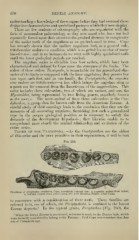Page 460 - My FlipBook
P. 460
470 DENTAL ANATOMY.
understanding a knowledge of these organs before they had assumed those
distinctive characteristics and speciaHzed patterns which they now display.
There are few students of odontography who are acquainted M'ith the
facts of mammalian palneontology as they now stand who have not had
repeatedly forced upon their attention the gradual decrease in complexity
of the molar teeth of the ungulates as we go backward in time. Cope
has recently shown that the earliest ungulates had, as a general rule,
tritubercular molars—a condition which is as primitive as that of many
insectivorjes ; and in no instance do we meet with highly specialized teeth
until the latest geological periods are reached.
The ungulate series is divisible into four orders, which have been
characterized and defined by Cope upon the structure of the limbs. The
oldest of these orders, Taxeopoda, is remarkable f(3r the generalized cha-
racter of the limbs as compared with the later ungulates ; they possess live
toes upon each foot, and in one family, the Periptychida', the superior
true molars are tritubercular—a fact which brings the ungulate stem to
a point not far removed from the Insectivora of the unguiculates. This
order includes three sub-orders, two of which are extinct, and one, the
Hyracoidea, being represented by two living genera, popularly known
as the coneys. The most ancient of these three sub-orders is the (hn-
dylarthra, a group thus far known only from the American Eocene. A
careful study of their osteology leads to the conclusion that they are the
ancestors of all succeeding ungulates, furnishing just such a generalized
type in the proper geological position as is necessary to satisfy the
demands of the development hypothesis ; they likewise enable us to
comprehend more clearly the mutual relationship and evolution of the
entire series.
Teeth of the Taxeopoda.—As the Condylarthra are the oldest
of this order and the most primitive in their organization, it will be best
Fig. 250.
Dentition of Periptychvs rhnbdmlnn, Cope, two-thirds natural size: a, superior molars from below;
inferior molars from above— from the New Mexican Puerco (alter Cope).
//
to commence with a consideration of their teeth. Three families are
referred to it, one of which, the Per iptych idee, is confined to the lowest
Eocene deposits.^ In the typical genus, Periptychu.s (Fig. 250), the
' When the lowest Eocene is mentioned, reference is made to the Pnerco beds, which
•were formerly considered to belong to the Tertiary ; Prof. Cope now considers tliat they
are of Cretaceous age.


